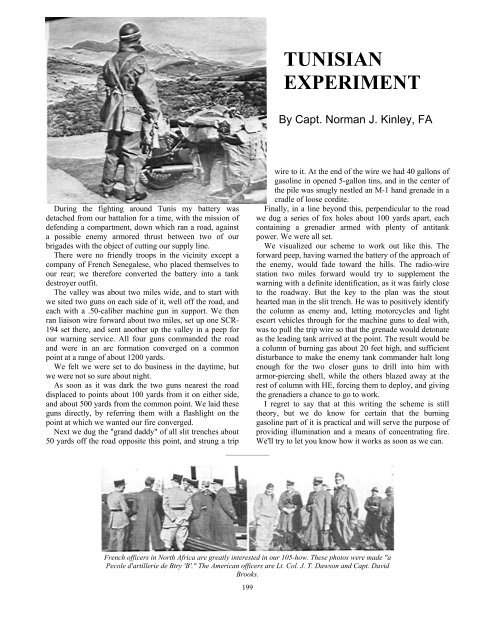the field artillery journal - Fort Sill - U.S. Army
the field artillery journal - Fort Sill - U.S. Army
the field artillery journal - Fort Sill - U.S. Army
Create successful ePaper yourself
Turn your PDF publications into a flip-book with our unique Google optimized e-Paper software.
During <strong>the</strong> fighting around Tunis my battery was<br />
detached from our battalion for a time, with <strong>the</strong> mission of<br />
defending a compartment, down which ran a road, against<br />
a possible enemy armored thrust between two of our<br />
brigades with <strong>the</strong> object of cutting our supply line.<br />
There were no friendly troops in <strong>the</strong> vicinity except a<br />
company of French Senegalese, who placed <strong>the</strong>mselves to<br />
our rear; we <strong>the</strong>refore converted <strong>the</strong> battery into a tank<br />
destroyer outfit.<br />
The valley was about two miles wide, and to start with<br />
we sited two guns on each side of it, well off <strong>the</strong> road, and<br />
each with a .50-caliber machine gun in support. We <strong>the</strong>n<br />
ran liaison wire forward about two miles, set up one SCR-<br />
194 set <strong>the</strong>re, and sent ano<strong>the</strong>r up <strong>the</strong> valley in a peep for<br />
our warning service. All four guns commanded <strong>the</strong> road<br />
and were in an arc formation converged on a common<br />
point at a range of about 1200 yards.<br />
We felt we were set to do business in <strong>the</strong> daytime, but<br />
we were not so sure about night.<br />
As soon as it was dark <strong>the</strong> two guns nearest <strong>the</strong> road<br />
displaced to points about 100 yards from it on ei<strong>the</strong>r side,<br />
and about 500 yards from <strong>the</strong> common point. We laid <strong>the</strong>se<br />
guns directly, by referring <strong>the</strong>m with a flashlight on <strong>the</strong><br />
point at which we wanted our fire converged.<br />
Next we dug <strong>the</strong> "grand daddy" of all slit trenches about<br />
50 yards off <strong>the</strong> road opposite this point, and strung a trip<br />
——————<br />
TUNISIAN<br />
EXPERIMENT<br />
By Capt. Norman J. Kinley, FA<br />
wire to it. At <strong>the</strong> end of <strong>the</strong> wire we had 40 gallons of<br />
gasoline in opened 5-gallon tins, and in <strong>the</strong> center of<br />
<strong>the</strong> pile was snugly nestled an M-1 hand grenade in a<br />
cradle of loose cordite.<br />
Finally, in a line beyond this, perpendicular to <strong>the</strong> road<br />
we dug a series of fox holes about 100 yards apart, each<br />
containing a grenadier armed with plenty of antitank<br />
power. We were all set.<br />
We visualized our scheme to work out like this. The<br />
forward peep, having warned <strong>the</strong> battery of <strong>the</strong> approach of<br />
<strong>the</strong> enemy, would fade toward <strong>the</strong> hills. The radio-wire<br />
station two miles forward would try to supplement <strong>the</strong><br />
warning with a definite identification, as it was fairly close<br />
to <strong>the</strong> roadway. But <strong>the</strong> key to <strong>the</strong> plan was <strong>the</strong> stout<br />
hearted man in <strong>the</strong> slit trench. He was to positively identify<br />
<strong>the</strong> column as enemy and, letting motorcycles and light<br />
escort vehicles through for <strong>the</strong> machine guns to deal with,<br />
was to pull <strong>the</strong> trip wire so that <strong>the</strong> grenade would detonate<br />
as <strong>the</strong> leading tank arrived at <strong>the</strong> point. The result would be<br />
a column of burning gas about 20 feet high, and sufficient<br />
disturbance to make <strong>the</strong> enemy tank commander halt long<br />
enough for <strong>the</strong> two closer guns to drill into him with<br />
armor-piercing shell, while <strong>the</strong> o<strong>the</strong>rs blazed away at <strong>the</strong><br />
rest of column with HE, forcing <strong>the</strong>m to deploy, and giving<br />
<strong>the</strong> grenadiers a chance to go to work.<br />
I regret to say that at this writing <strong>the</strong> scheme is still<br />
<strong>the</strong>ory, but we do know for certain that <strong>the</strong> burning<br />
gasoline part of it is practical and will serve <strong>the</strong> purpose of<br />
providing illumination and a means of concentrating fire.<br />
We'll try to let you know how it works as soon as we can.<br />
French officers in North Africa are greatly interested in our 105-how. These photos were made "a<br />
Pecole d'artillerie de Btry 'B'." The American officers are Lt. Col. J. T. Dawson and Capt. David<br />
Brooks.<br />
199

















